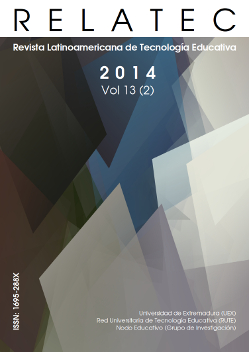Las políticas educativas TIC en España después del Programa Escuela 2.0: las tendencias que emergen / ICT education policies in Spain after School Program 2.0: Emerging Trends
DOI:
https://doi.org/10.17398/1695-288X.13.2.11Keywords:
Política educativa, Escuela 2.0, modelo 1, 1, Tecnología Educativa, TICAbstract
En este artículo se analiza la situación actual de las políticas educativas destinadas a la incorporación de las TIC a las escuelas en una muestra de ocho comunidades autónomas de España (Andalucía, Canarias, Cataluña, Extremadura, Madrid, País Valenciano, País Vasco y Principado de Asturias) después del proceso impulsado por el Programa Escuela 2.0. Este programa estuvo vigente durante el periodo 2009-2012 y respondió al modelo 1:1, de un ordenador por estudiante. Este análisis se guió por las siguientes cuestiones: ¿Qué efectos permanecen de las experiencias de políticas educativas del modelo 1:1?; ¿Qué nuevos proyectos o programas están vigentes en los sistemas educativos de las comunidades autónomas? ¿Qué nuevas tendencias con relación a las TIC están emergiendo en la agenda educativa de las políticas autonómicas? Se concluye que las nuevas políticas TIC, entre otras acciones, apuntan a centrar su atención en la incorporación de las PDI a todas las aulas, a la dotación de tabletas a los estudiantes en vez de miniportátiles, a políticas de sustitución de los libros de texto de papel por plataformas de contenidos digitales y a la creación de portales de recursos en la nube. Se constata también la ausencia de un programa o política educativa TIC coordinada a nivel de todo el estado como fue la experiencia del Programa Escuela 2.0.
Abstract
In this article the current situation of educational policies for the incorporation of ICT in schools in a sample of eight regions of Spain (Andalusia, Canary Islands, Catalonia, Extremadura, Madrid, Valencia, the Basque Country and the Principality of analyzes Asturias) after the process driven by the Escuela 2.0 program. This program was in effect during the period 2009-2012 and responded to the 1:1 model of a computer per student. This analysis was guided by the following questions: What effects remain from the experiences of educational policies of the 1:1 model?; What new projects or programs are in place in the educational systems of the regions? What new trends in relation to ICT are emerging in the educational agenda of regional policies? We conclude that the new ICT policy, among other things, aim to focus on the integration of IDPs to all classrooms to equipping students tablets instead of netbooks, a substitution policies textbooks paper for digital content platforms, to create portals of cloud resources. The absence of an educational program or policy level ICT coordinated statewide as was the experience of School Program 2.0 has been observed.
Downloads
Downloads
Published
Issue
Section
License
Authors who publish in this journal accept the following conditions:
1. The Author retains copyright in the article. Upon acceptance of the article, the author shall grant to the Publisher the right of first publication of the article. with the dcoument registered with the Creative Commons Attribution-NonCommercial-NoDerivative 4.0 International (CC BY-NC-ND) license, which allows to third parties to use what is published whenever they mention the authorship of the work and the first publication in this journal.
2. Authors can make other independent and additional contractual agreements for the non-exclusive distribution of the article published in this journal (eg, include it in an institutional repository or publish it in a book) provided they clearly indicate that the work was published for the first time in this journal.
3. Authors are allowed and recommended to publish their work on the Internet (for example on institutional or personal pages) before and during the review and publication process, as it can lead to productive exchanges and a greater and faster diffusion of published work (see The Effect of Open Access).









